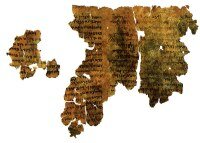From Ancient Greek pseudes = "false", epigraphe = "inscription", Pseudepigrapha are falsely attributed works, texts whose claimed authorship is unfounded; a work, simply, "whose real author attributed it to a figure of the past." For instance, few Hebrew scholars would ascribe the Book of Enoch to the prophet Enoch, and few liberal Christian scholars would insist today that the Third Epistle of John was written by John the Evangelist, or that the Second Epistle of Peter was written by Simon Peter. Nevertheless, in some cases, especially for books belonging to a religious canon, the question of whether a text is pseudepigraphical or not elicits sensations of loyalty and can become a matter of heavy dispute. The authenticity or value of the work itself, which is a separate question for experienced readers, often becomes sentimentally entangled in the association. Though the inherent value of the text may not be called into question, the weight of a revered or even apostolic author lends authority to a text: in Antiquity pseudepigraphy was "an accepted and honored custom practiced by students/admirers of a revered figure". This is the essential motivation for pseudepigraphy in the first place.
Pseudepigraphy covers the false ascription of names of authors to works, even to perfectly authentic works that make no such claim within their text. Thus a widely accepted but incorrect attribution of authorship may make a perfectly authentic text pseudepigraphical. Assessing the actual writer of a text brings questions of pseudepigraphical attributions within the discipline of literary criticism. In a parallel case, forgers have been known to improve the market value of a perfectly genuine 17th-century Dutch painting by adding a painted signature Rembrandt fecit (i.e. fecit: "made by or did. Aquatinta fecit: engraved in aquatint by").
More...
Subscribe to:
Post Comments (Atom)
Blog Archive
-
▼
10
(326)
-
▼
November
(27)
- Jesus
- Eusebius of Caesarea
- Fertile Crescent
- Isaac
- F.F. Bruce
- disciple
- Shekhinah
- ONE Modern Day Prophet
- Tribe of Asher
- Friedrich Wilhelm Nietzsche
- Early Church Fathers
- Leo Tolstoy
- Lucifer
- HOPE
- "Son of God"
- Pseudepigrapha
- The Temple Mount
- Adolf Hitler, rise to power
- Samaria
- Sumer
- Jesus the man
- Apocatastasis
- Unconditional Love
- Zealot
- Johann Sebastian Bach
- N.T. Wright
- Dystopia
-
▼
November
(27)
LifeNews.com
Desiring God Blog
Youth for Christ International
related
- Follow Jesus
- Timothy Ministries News
- Dallas Willard
- Christian Resources
- Missional Church dot Org
- Between Two Worlds
- GinkWorld
- New Tribes Mission
- Prime Time Jesus
- All Things Aramaic
- Blogging the New Testament
- Campus Crusade for Christ International
- Bible.org
- Vineyard South Africa
- AnswersInGenesis
- Allelon Movement of Missional Churches
- Billy Graham
- Christian Classics Ethereal Library
- Christian answers
- Christian Worldview
- Historical Jesus Studies
- Monergism
- Christians Unite



No comments:
Post a Comment